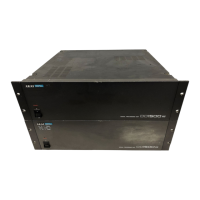UTILITIES - DIRECTORY - 21
Version 2.00 - March, 1996 Page 213
COPYING EDITS FROM PROJECTS TO LIBRARIES
It is also possible to build libraries using the DD1500’s editing functions. In this way, you
can copy perfectly edited cues from a project to a library for use at a later date.
For example, you may be working on a project that requires a thunder clap so you scour
your CD sound effects collection and record a thunder clap that is appropriate. Naturally,
the recording needs some ‘tweaking’ so you edit the thunder clap. Maybe you use
DISCARD to get rid of unwanted rubbish either side of the IN and OUT times. Then you
maybe mark a SYNC marker at the point where the thunder clap ‘explodes’. Maybe you
set a fade in and fade out to finally tidy it up and then adjust its level. This could then be
copied to a library called WEATHER as a generic thunder clap sound effect for use in
another project at some later date. When copied to the library, the fade in/out and level
set in EDIT CUE would be stored as would the SYNC point so that, in future, whenever
you need a good thunder clap, all you need do is call up that sound effect (from your
WEATHER library) and paste or insert it, perfectly synced and edited into some other
project.
This could take place when you are working on a project and you think that a particular
element of that project could be useful at a later date. However, you could use the
DD1500’s recording and editing to specifically build a central library of useful recordings for
general use.
There are several ways this can be done.
Firstly, create a new, empty project using NEW PROJECT in LOAD (SHIFT+SAVE). You
could take your sound effects (or music - whatever) CD, DAT, TAPE (whatever) and record
that into the new project. At this point, you could select to also place this recording into a
library of your choosing so that you always have the ‘raw’ recording to fall back on. You
could just let the CD/DAT/TAPE run, recording everything as one long recording. When
that’s done, you could go through the recording, isolating each sound effect by setting IN,
SYNC and OUT times as necessary, using SPLIT to create separate cues, setting level
and fade up/down parameters in EDIT CUE and copying them off to libraries you may
have created as appropriate (using COPY, TO LIBRARY, naming as you wish, EXECUTE).
You may, if you wish, choose to save this project but you may prefer to just abort this,
using the project just as a ‘scratchpad’ to get audio into the system.
Another method may be to record each sound effect in separately directly to the project
(and not to a library), editing each recording immediately after recording (DISCARD, EDIT
CUE fade up/down, etc.) and copying (or cutting) each one to an appropriate library.
Because the project you are using is just a ‘scratchpad’, that project need not be saved as
it was just a vehicle for getting the recordings in. It’s up to you! Also, whether you choose
to place these ‘raw’ recording in a library is for you to decide.
There are many ways in which you can build libraries and no way is better than others. No
doubt, you will find your own method depending on what’s best for your working practices.
However you choose to do it, operation is consistent - record the material into a project,
edit it if necessary and copy it to a library.

